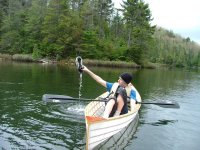Turns out my dad's grandson, Evan, is a natural at canoeing. 10 years old and never held a paddle before this summer when we took him out for the first time. The only advice I have him was to keep his paddle shaft more vertical and figured I'd let him make his own mistakes from there. He immediately figured out which side paddled made the boat go left or right and within 10 minutes he'd developed a pry stroke. 10 minutes after that I caught him doing a draw. Half way through to trip I let him take the stern and told him he was in charge. He did pretty good.
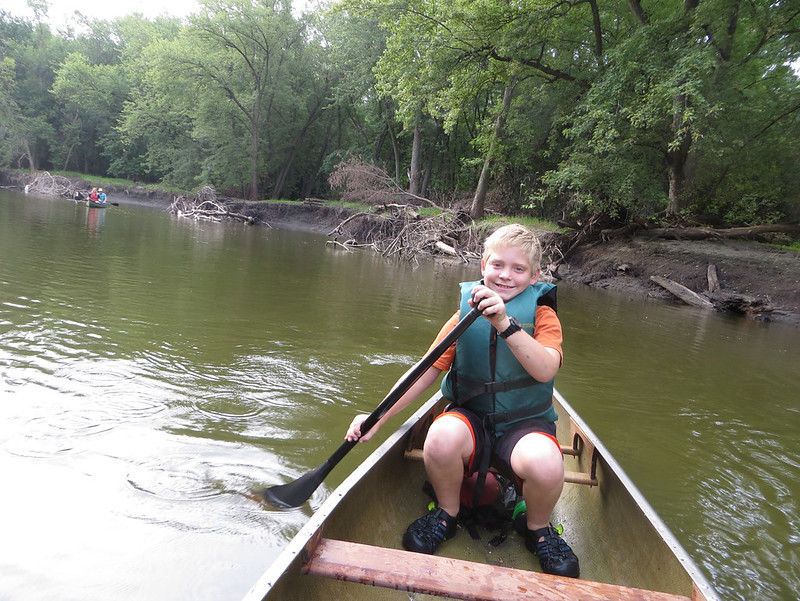
20140809_002 by Alan Gage, on Flickr
After the trip my dad told him he and his cousin could have his old 12' Dolphin tandem. I used that boat as a kid too. They've paddled it a couple times now and last time I took him out on the lake he paddled it solo while I took one of my solos. He did great but it's really heavy and really wide. I told my dad he needed to build a boat with Evan that he could actually handle but I could tell that wasn't going to get done so I took matters into my own hands. Found plans for the 12' Snowshoe at www.gaboats.com and started charging the supplies to my dad.
It's supposed to be a pretty quick and easy method but I'm not so sure about that. Woodstrip seems easier but that's probably because I've done a couple. This is all new so lots of reading and re-reading and scratching my head and trying to figure out what exactly he's talking about. Also steam bending ribs, which is new, but it went fine once I started.

20141002_001 by Alan Gage, on Flickr
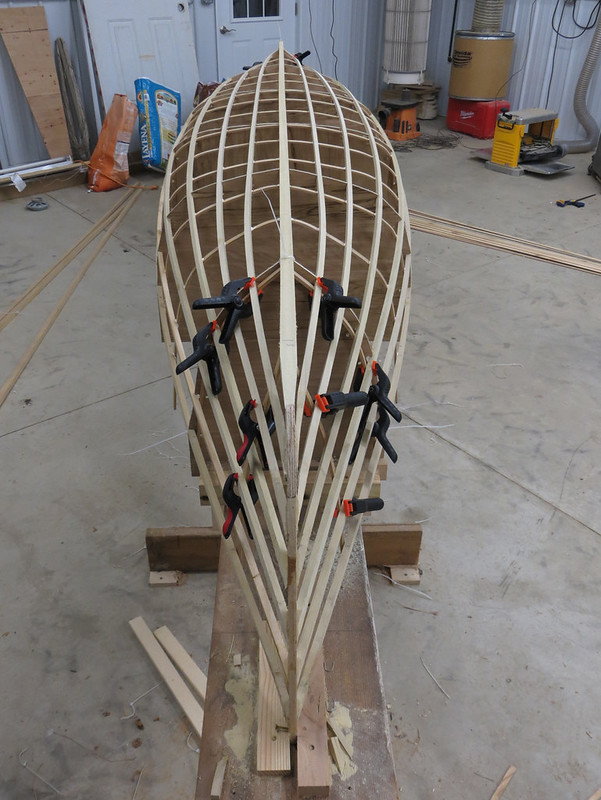
20141002_002 by Alan Gage, on Flickr
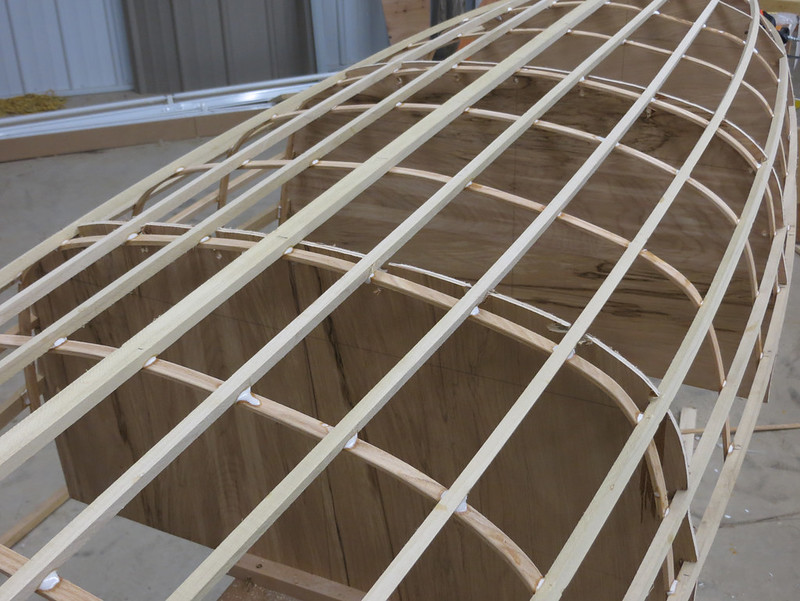
20141002_004 by Alan Gage, on Flickr
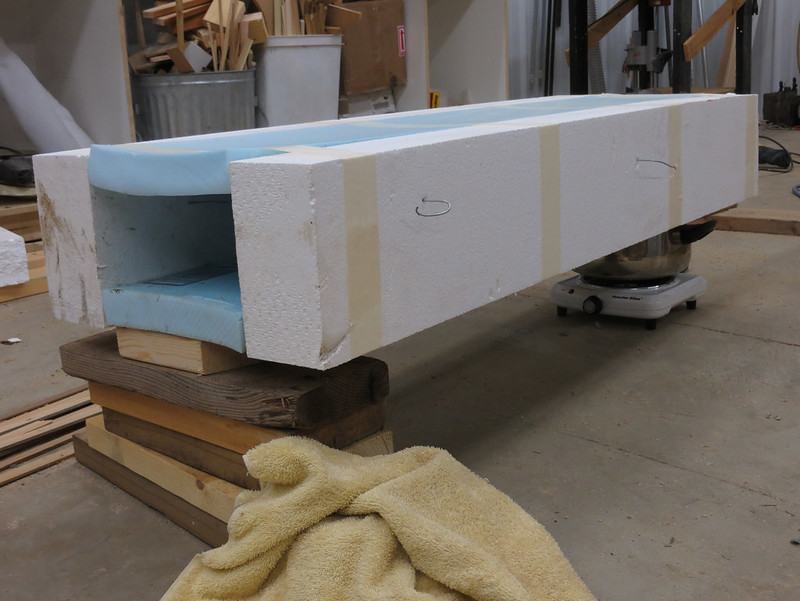
20141002_003 by Alan Gage, on Flickr
I thought building the steam box and steaming the ribs would be a pain in the butt so I kind of drug my feet but it was pretty easy once I actually got to it. The foam thickness (4") is obviously overkill but those were the scraps I had on hand. I wanted to use duct tape but masking tape was the only thing I could find at the time and it worked fine. No other fasteners required. The back of the box is sealed shut and the towel is draped over the front. On top of the pot is a 3/4" piece of plywood with a 2" hole cut in it. In the bottom of the foam there is a matching 2" hole. Line up the holes, turn on the heat, and voila!, instant steam.
All the ribs are glued in place except for the last 4 (two end ribs on in bow and stern). I steamed and clamped them tonight. Tomorrow I'll glue. I'd really like to get it skinned and start water proofing it this weekend, but we'll see. I've got other stuff going on too which is a bit more important but I'd like to have it done by the following weekend when the county nature center is having a little "fall colors" paddle on one of the local lakes. I'm sure Evan would love to carry his own boat off the rack, plop it in the water, and paddle away by himself with a crowd watching.
Alan

20140809_002 by Alan Gage, on Flickr
After the trip my dad told him he and his cousin could have his old 12' Dolphin tandem. I used that boat as a kid too. They've paddled it a couple times now and last time I took him out on the lake he paddled it solo while I took one of my solos. He did great but it's really heavy and really wide. I told my dad he needed to build a boat with Evan that he could actually handle but I could tell that wasn't going to get done so I took matters into my own hands. Found plans for the 12' Snowshoe at www.gaboats.com and started charging the supplies to my dad.
It's supposed to be a pretty quick and easy method but I'm not so sure about that. Woodstrip seems easier but that's probably because I've done a couple. This is all new so lots of reading and re-reading and scratching my head and trying to figure out what exactly he's talking about. Also steam bending ribs, which is new, but it went fine once I started.

20141002_001 by Alan Gage, on Flickr

20141002_002 by Alan Gage, on Flickr

20141002_004 by Alan Gage, on Flickr

20141002_003 by Alan Gage, on Flickr
I thought building the steam box and steaming the ribs would be a pain in the butt so I kind of drug my feet but it was pretty easy once I actually got to it. The foam thickness (4") is obviously overkill but those were the scraps I had on hand. I wanted to use duct tape but masking tape was the only thing I could find at the time and it worked fine. No other fasteners required. The back of the box is sealed shut and the towel is draped over the front. On top of the pot is a 3/4" piece of plywood with a 2" hole cut in it. In the bottom of the foam there is a matching 2" hole. Line up the holes, turn on the heat, and voila!, instant steam.
All the ribs are glued in place except for the last 4 (two end ribs on in bow and stern). I steamed and clamped them tonight. Tomorrow I'll glue. I'd really like to get it skinned and start water proofing it this weekend, but we'll see. I've got other stuff going on too which is a bit more important but I'd like to have it done by the following weekend when the county nature center is having a little "fall colors" paddle on one of the local lakes. I'm sure Evan would love to carry his own boat off the rack, plop it in the water, and paddle away by himself with a crowd watching.
Alan

